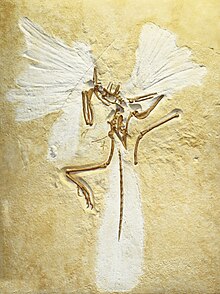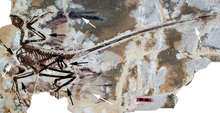The Origin of Birds
[6] Based essentially on a process of elimination, Heilmann arrives at the conclusion that birds must be descended from thecodonts, a group of archosaurs that lived during the Permian and Triassic periods.
The Hungarian paleontologist Franz Nopcsa proposed an alternate hypothesis in 1907, arguing that the ancestors of birds were fast-running, bipedal animals related to theropod dinosaurs.
[5] Between 1913 and 1916, Gerhard Heilmann published a series of articles in the journal of the Danish Ornithological Society, all heavily illustrated and dealing with the question of the origin of birds.
[5] Heilmann's articles were later collected and published as a book in Danish in 1916 with the title as in his series, Vor Nuvaerende Viden om Fuglenes Afstamming ("our present knowledge about the origin of birds").
Examining this important specimen in person allowed Heilmann to add some additional details and revisions to his understanding of the hip, the skull, and the flight feathers.
The English edition was somewhat shorter and more concise, and included newer information that Heilmann had acquired by studying the actual fossils of Archaeopteryx in Berlin, as well as from foreign scientists who sent him photographs and plaster casts.
Curiously, the English edition did not contain the transformational sequences inspired by D'Arcy Thompson, though Heilmann still briefly acknowledged the use of his methods in reconstructing his Proavis.
[1] In the first section, Heilmann examines in exquisite detail the fossil remains of several extinct birds, including Hesperornis, Ichthyornis, Archaeopteryx, and "Archaeornis", the name used commonly at the time for the Berlin specimen, which was then thought to represent a separate genus.
Heilmann's attention to detail in his artwork is inspired at least in part by his dissatisfaction with anatomical renderings of these animals in scholarly works of the time, which he deemed as "unsatisfactory" and "containing misleading errors.
"[12] Early in this section Heilmann embarks on a thorough description of the Berlin Archaeopteryx specimen, which includes detailed comparisons to specific aspects of modern birds.
[18] The latter part of this section deals with analyzing the skeletal anatomy of the fossil birds Hesperornis and Ichthyornis, but Heilmann ultimately decides that they are of no importance to his investigations.
He finds a striking resemblance between the embryonic development of reptiles and birds, including details of the skeletal anatomy (with special attention to the hands and feet) and various organs.
Of more interest to his goal, Heilmann writes in a similar vein that the embryos of certain birds clearly show a three-clawed finger structure, at least one of which (the hoatzin) retains actual claws after hatching.
He mentions other anatomical features of bird embryos that hint at their reptilian ancestry as well, such as the embryonic splitting of the pygostyle into distinct separate vertebrae.
He writes that secondary sexual characteristics are also similar between birds and reptiles, with both groups frequently utilizing bright colors and structures for display.
One consistently confounding issue Heilmann had encountered in his research into the bird-reptile link was that modern birds possess a wishbone and theropod dinosaurs, by his observations, did not.
Since ancient reptilian fossils that predated dinosaurs clearly possessed a different sort of wishbone, Heilmann concluded that this feature could not have been lost and regained again over the course of evolution.
[33] He imagines that these reptiles would have gradually assumed a bipedal gait, and transformed eventually from terrestrial runners to arboreal climbers, developing leaping capabilities ever increasing in length.
[39] The proposed thecodontian ancestry eventually fell out of favor, in part because the clade "thecodontia" is not monophyletic, meaning that it has no unique, diagnostic characteristics (and is largely considered an obsolete grouping today).
[38] Most coincidentally, a small theropod dinosaur named Oviraptor philoceratops had been discovered while Heilmann was working on his book, and was described by Henry Fairfield Osborn in 1924.
[45] Some years later, Ostrom also reanalyzed the fossils of Archaeopteryx, concluding that the animal was more reptilian than originally described by Heilmann, noting in particular the similarity of its feet to those of Deinonychus, as well as a host of other features.
In this proposed mode of bird evolution, Heilmann's "Proavis" is strongly implicated, which would have probably been a climbing, perching, early-stage gliding quadruped.
This hypothesis was based on observations of bird embryos and hatchlings, which Beebe found to possess a presumably atavistic fringe of flight feathers on their hindlimbs.
He theorized based on this embryological fringe and the recapitulation theory that birds had once passed through a "Tetrapteryx" stage in their distant evolution, which he represented as a hypothetical four-winged gliding animal.
[51] Despite this, Heilmann's Proavis illustrations sport a short border of feathers behind the thigh, which some authors have suggested was inspired by Beebe's Tetrapteryx idea.
[52] Beebe was relatively undeterred by the scientific community's acceptance of Heilmann's rejection of his theory, as is evidenced by the fact that he was still writing about his Tetrapteryx hypothesis well into the 1940s.
[53] His adherence to his theory was well-placed, as in 2003 a revolutionary discovery was made in the early Cretaceous Jiufotang Formation of Liaoning, China: Microraptor gui, the small, four-winged dromaeosaur that had led to renewed credence of the arboreal model for the origin of bird flight.
This animal's most remarkable feature was the existence of long, pennaceous feathers on both its arms and legs, forming a set of four aerodynamic wings that its discoverers theorized were used for gliding.
[55] Today, Beebe's 1915 description of his hypothetical four-winged bird ancestor is regarded as prescient, and there is no doubt that Microraptor looks startlingly similar to the almost-century old Tetrapteryx illustrations.
[56] After its discovery, Microraptor had the effect of both reinvigorating the arboreal hypothesis as well as finally putting an end to the widespread acceptance of Heilmann's disregard for the Tetrapteryx theory.








